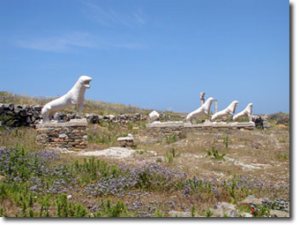The legend around the island is that Leto, Zeus’ lover was banned from all land when Zeus’ legitimate wife found out Leto’s pregnancy. That’s why Poseidon, the God of water, revealed a small bit of land, which had been covered in water, so that she can go there and give birth to Zeus’ child. Delos means “revealed”.
Between 11th and 7th centuries BC, Ionians inhabited the island and they developed it into a powerful trade and spiritual centre. During 4th century BC an interesting process took place -the Athenians did “purification” of the island – they banned all the burials and all the births on the island. The dead were buried on the neighboring island of Rhenia, which was transformed into a necropolis. After the purification, enormous and glamorous ceremonies in honour of Apollo were organized every 5 years. You’ll get a strong sense of that history as you wonder round the UNESCO protected ruins. For a sense of the layout of this ‘open air museum’, just head for the top of Mount Kythnos and peer down.
Some of the places worth visiting at Delos are the following:
- The Agora of the Competaliasts – this is one of the main markets on the island of Delos, which was created in the last quarter of the 2nd century BC. This place is directly adjacent to the Sacred Harbour. The foundations of a square and a round marble monument, both dedicated to the god Hermes, can be seen in the center of the market square. Around these two monuments, one can discover the remnants of many other monuments erected by merchants, sea captains, and bankers. In the northern side of this market, one can find the Portico of Philip and an Ionic temple – dedicated to Hermes. In the eastern and southern ends, there are the remains of shops from the golden days of this Hellenic commerce center (about a thousand years ago). The ground is paved with coble stones, which created an additional vernacular atmosphere.
- The Doric order was one of the three types or organizational systems of Ancient Greek (classical) architecture; the other two orders were called the Ionic and the Corinthian. The Greek Doric order was the earliest of these, known from the 7th century BC and reaching its developed form in the 5th century BC. In their original Greek version, Doric columns stood directly on the plain pavement (the stylobate) of a temple without any base whatsoever; their vertical shafts were fluted with parallel concave grooves; and they were topped by a smooth capital that flared from the column to meet a square abacus at the intersection with the horizontal beam (“entablature”) that they carried.
- There are a couple of ancient buildings where you can observe the Doric order in the whole of its splendour.
- The Stoivadeion temple contains a rectangular platform containing a statue of Dionysos which was framed by two actors impersonating Paposilenoi. These actors are now in the Delos Museum for security reason. There are two pillars, one on each side of the platform, each supporting a huge phallus, the symbol of Dionysos. The southern pillar is decorated with relief scenes of a Dionysiac circle, and bears an inscription that it was erected ca. 300 B.C. by a Delian named Karystios in commemoration of a victorious theatrical performance he sponsored.
Archaeological Museum of Delos
The Archaeological Museum of Delos was built in the year 1904. The museum contains of Archaic, Classical, Hellenistic and Roman sculptures.The most important are the Archaic Sphynx of the Naxias and Acroteria (Victories) from the Temple of the Athenians, sculptural complexes showing Orithyia being carried off by Boreas and Aurora with Kefalos. Find also of all periods collection of vases, various small object and household utensils.
Rates – Departure Point
Ticket prices for a trip to Delos begin at 10 € (for children 6-12 years old). The ticket for adults costs 20 €, while for children up to 6 years old the transit is free of charge. Departures are daily from the small harbor opposite the chapel of Saint Nicholas at the beach side of Mykonos Town (Chora). Tickets can be purchased from the ticket office which is located right in front of the ferries 15 minutes before departure.
Departure Schedule
Tuesday – Sunday: Departure Time: 9:00 – 10:00 – 11:30 – 17:00.
Return to Mykonos: 12:00 – 13:30 – 15:00 – 19:30.
Monday: Departure Time: 10:00 – 17:00.
Return to Mykonos: 13:30 – 19:30.
Main Delos Ticketing Agencies
- ‘Delos travel‘, Drafaki, Mykonos Tel: 22890 28603
- ‘Likouris Travel‘, Fabrika, Mykonos Tel: 22890 24439
- ‘Sea & Sky Travel‘, Manto Square, Mykonos Tel: 22890 22853



